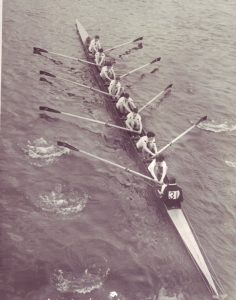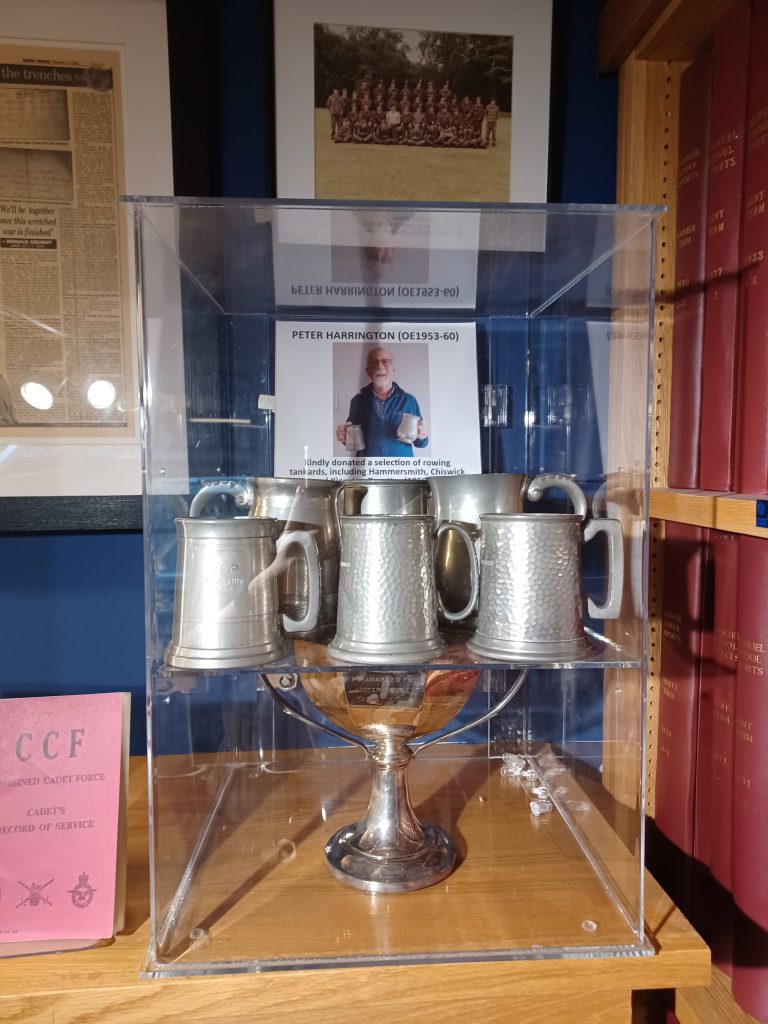We are always incredibly grateful to alumni who donate their precious artefacts and objects to the permanent School Archive, so others can marvel in their history. The six rowing tankards featured in this article were won by Peter Harrington (OE1953-60) between 1958 and 1960, just as Emanuel was about to enter its first golden era of schoolboy rowing. Emanuel dominated the river throughout the sixties and into the seventies. Featured in this lovely collection are the following tankards:
| Vesta Open Events Committee | Autumn Lightweight VIIIs 1958 |
| Vesta Open Events Committee | Autumn Lightweight VIII’s 1959 |
| Vesta Rowing Club Trial VIII’s | |
| Hammersmith Amateur Regatta 1959 | Junior VIII’s |
| Chiswick Amateur Regatta 1960 | School VIII’s |
| Kingston Amateur Regatta 1960 | School VIII’s |
Peter’s 1960 crew were John Edmonds (cox), Barry McDonnell (stroke), John Dashper (seven), Dave Cook (six), Jim Pryor (five), John Stratton (four), Ron Brown (three), himself (two) and Henry King (bow). After leaving school, Peter was one of the founding members of the Dacre Boat Club, which rowed competitively for many years, including at Henley and other top events in the rowing calendar.
As a boy, Peter made many great friends at Emanuel and recalled “I kept in touch with Dave Cook (until he passed away a few years ago). I am still in contact with Henry King and Jim Pryor, most recently in the last few months. From Australia, I have visited David and Jim in Canada and Henry in England at Henley (he is now a Henley Royal Regatta Steward) and his home in Yorkshire in 2012. Now in our eighties, it is testimony to the lifelong friendships formed at Emanuel.”
Peter’s blood runs true blue and gold, as his father Derek was also an OE who attended the school from 1926 to 1933. Derek was an outstanding schoolboy who hooked for the First Fifteen, rowed for the First Eight and was Captain of Boats. Both father and son were members of Clyde House.
In a recollection first published in The History of Emanuel School Boat Club (written by Daniel Kirmatzis) Peter recalls his time rowing at Emanuel:
‘Training took place on Wednesday afternoons and Saturday mornings in the autumn and spring terms. Training also took place after school on weekdays after daylight saving commenced. Coaches were Derek Drury (1st VIII), Dick Edwards (2nd VIII), Messrs Matthews and Chandler (3rd VIII and 4th VIIIs), and Denis Whitcombe, Charles Hill and later, Peter Hendry and a visiting German exchange teacher, Herr Küsterle, taught the starters and Colts VIIIs. In around 1957 the (then) new training method of circuit training in the gym was instituted during the winter months, starting at 8.00am before school on non–rowing weekdays for the 1st and 2nd VIIIs. Fitness levels increased markedly as a result and the beginning of a general improvement in Emanuel rowing began.
‘Training through the autumn and spring terms was geared towards the two ‘Heads’ in March – the Schools Head of the River Race from Hammersmith to Putney and the Open Head of the River Race over the university Boat Race course, but in reverse. An annual friendly race between Emanuel and City of London School was held in the autumn term and a race against an old boys’ crew was also held at the beginning of the year. I suspect that this did not eventuate every year, because of the difficulty in putting together the old boys’ crew. While boating from Vesta, the school entered the Vesta RC Open Events Committee’s Lightweight Eights for the Grace Sabin Challenge Vase. The ESBC 1st Lightweight VIII won this event in both 1958 and 1959 and the 2nd VIII also won the VRC Trial VIIIs in 1959 (a handicapped event).
For the 1st VIII the receipt of an invitation to pace Oxford or Cambridge in their pre–Boat Race training on the tideway was a great honour.
After Easter, training concentrated on the shorter distances and side-by-side racing involved in regattas and the London Schools Leagues. Similar to the Football League there were a number of divisions with about four or five crews in each. Typical opponents included City of London School, St. Paul’s School, Westminster School, Latymer Upper School, Quintin, Ealing Grammar and King’s College School Wimbledon.
The inter-house rowing competition was not a major event for two reasons: the school did not own any fours (apart from the tub IV) for practice and in 1955 when there were only three VIIIs the available pool of around 30 boys meant many houses could not put out a crew. If a house could find 5 boys, they might all be junior oarsmen who could be drawn against a (lucky) house that contained members of the 1st VIII.
During the 1955-60 period, the ESBC 1st VIII generally finished in the top 15 in the Schools HoRR and an indication of things to come occurred in 1956 when it came 2nd. Possibly as a result, Emanuel entered two VIIIs in the Open HoRR for the first time in 1958. I recall both crews underwent a medical check, (held in the school dining hall) because of the (then) perceived stresses of the event on young hearts.
In the 1960 Open Head the 2nd VIII rose 17 positions while the 1st VIII dropped 20 places with the result that the 1st VIII was rearranged for the summer. Although the new crew was very lightweight, Derek Drury’s coaching expertise was vindicated and the rearranged VIII won all its League 2 races reasonably comfortably and was promoted to League 1 for the first time in 1961.
The 1st VIII had been in League 5 in 1956 and had been promoted a league in 4 of the previous 5 years. This crew continued its success at a number of regattas on the Thames entering the Putney, Hammersmith, Kingston, Barnes and Mortlake, Staines, Metropolitan, Maidenhead, and Henley Town and Visitors regattas. It won School Eights at Chiswick and Kingston and Junior Eights at Hammersmith. The results in the Open Head had precluded entering the crew for Marlow and for Henley Royal regattas, entries for which had closed before the improvement in the VIII’s summer performance became apparent.
A feature of the 1960 VIII’s racing that left many a parent or supporter with their heart in their mouth was its slow start and many of the races were won by coming from behind. Emanuel was fortunate in having strong support from parents and friends. Number 7 was John Sturgeon and his girlfriend was known sometimes to follow the crew on the towpath at Barnes on a horse. No. 6 (Dave Cook) used to “collect” the blade colours of clubs and schools, entering them in a notebook held by his mother who he tested for her knowledge of the collection!’
Although Peter has lived in Australia for many years, he has visited Emanuel on occasion whilst back in the UK and previously gifted his rowing boater to the Archive and wrote a memoir on his father called A Queen’s Man which was used in our 2014 book Emanuel School at War. Back in 2004, Peter also wrote an informative booklet on Emanuel’s Houses which explained the history and background of the House system at Emanuel, including biographies of all military and naval leaders whom Houses were named after. We are very grateful to all his long-term support and the tankards are now on display in the permanent School Archive.
Mr T Jones, Senior Librarian and Archivist
Peter Harrington (OE1953-60)



























